
|
|
|
>> Log Handling, Sorting and Storing |
| Conveyance to Sawmill
|
| This section covers the hazards involved with getting logs from the
water or unloading site into the sawmill. Click on the following
links for more specific information:
|
|
|
|
|
|
|
Hazards/Solutions:
Workers may suffer
electrocution from circuits that are operating with
too much voltage.
- Circuits that set ungrounded, electrically powered hoists into action
must operate at less than 50 volts to ground.
1910.265(d)(2)(ii)(a)
Workers may be pinched, struck, or crushed by
moving logs.
- Roadbeds at log dumps must be a sufficient width and evenness to
insure safe operation of equipment.
1910.265(d)(2)(ii)(b)
- An adequate brow log or skid timbers or the equivalent must be
provided where necessary. Railroad-type dumps, when located where logs
are dumped directly into water or where entire loads are lifted from
vehicle, may be exempted providing such practice does not create a
hazard. 1910.265(d)(2)(ii)(c)
- Arrange unloading lines so it is not necessary for the
employees to attach them from the pond or dump side of the load except
when entire loads are lifted from the log-transporting vehicle.
1910.265(d)(2)(ii)(d)
- Unloading lines, crotch lines, or equally effective means must be used
to minimize the possibility of any log
from swinging or rolling back. 1910.265(d)(2)(ii)(e)
- When logs are unloaded with peavys or similar manual methods, provide
a means to minimize the danger from rolling or
swinging logs.
1910.265(d)(2)(ii)(f)
Workers may fall into the
pond and drown if proper safety measures are not in place.
- Guardrails, walkways, and standard handrails must be installed. 1910.265(d)(2)(ii)(g)
- Approved life rings (see: 46 CFR 160.099 and 46 CFR 160.050) with
line attached must be provided and maintained. 1910.265(d)(2)(ii)(h)
|

|
|
|
|
Hazards/Solutions:
Defective pike poles may be hazardous to workers. Metal pike poles
may electrocute
workers if used near electrical conductors.
- Wood pike poles must be made of straight-grained, select material.
Metal or conductive pike poles must not be used around exposed
energized electrical conductors. Do not use defective, blunt, or dull pike poles.
1910.265(d)(1)(ii)(j)
|
|
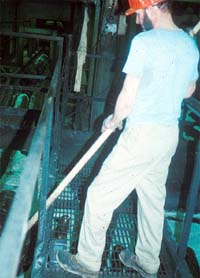
Worker moves logs from pond
onto jack ladder with
pike pole.
|
Workers may fall into the
pond and drown if proper safety measures are not in place, or if
equipment is not used in a safe manner.
- Walkways and floats must be installed and securely anchored to
provide adequate passageway for employees.
1910.265(d)(2)(iii)(a)
- All regular boom sticks and foot logs must be reasonably straight,
with no protruding knots and bark, and must be capable of supporting the
weight of an employee and
equipment.
1910.265(d)(2)(iii)(b)
- Permanent cable swifters must be arranged so that it will not be
necessary to roll boom sticks in order to attach or detach them.
1910.265(d)(2)(iii)(c)
- Periodic inspection of cable or dogging lines must be made to
determine when repair or removal from service is necessary.
1910.265(d)(2)(iii)(d)
- Stiff booms must be two float logs wide secured by boom chains or
other connecting devices, and of a width adequate for the working needs.
Walking surfaces need to be free of loose material and in good
repair.
1910.265(d)(2)(iii)(h)
- Boom sticks must be fastened together with adequate crossties or
couplings.
1910.265(d)(2)(iii)(i)
|
|
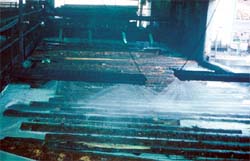
Hot pond inside mill
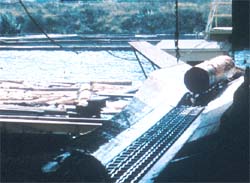
Chain conveyor moves logs
from boom pond into mill.
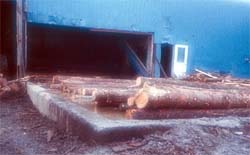
Hot pond in small sawmill where logs are
dumped for
conveyance into mill
|
- Employees who work from boats, floating
logs, boom sticks, or walkways along or on water must have and wear appropriate buoyant
devices.
1910.265(d)(2)(iii)(g)
|
|
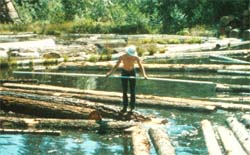
Boom pond worker has no
personal flotation device.
|
- Floating donkeys or other power-driven machinery used on booms must
be placed on a raft or float with enough buoyancy to keep the deck well
above water.
1910.265(d)(2)(iii)(j)
- All sorting gaps must have a substantial stiff boom on each side.
1910.265(d)(2)(iii)(k)
|
|
|
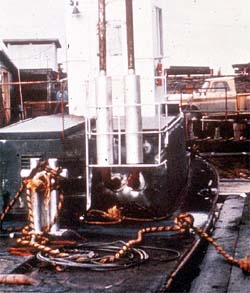
Non-slip material on pond boat
|
Stagnation or pollution in log
ponds can lead to health hazards for nearby workers.
- Artificial log ponds must be drained, cleaned, and refilled when
unhealthy stagnation or pollution occurs.
1910.265(d)(2)(iii)(f)
Fire on pond boats and rafts may lead to serious burns. Attempting to escape from a boat fire may
result in drowning.
- The applicable provisions of the Standard for
Fire Protection for Motorcraft, NFPA No. 302-1968, which is incorporated
by reference as specified in Sec. 1910.6, must be complied with. 1910.265(d)(2)(iv)
- Boat fuel must be transported and stored in approved safety
containers (Underwriters' Laboratories, Inc.).
1910.265(d)(2)(iv)(c)
|
|
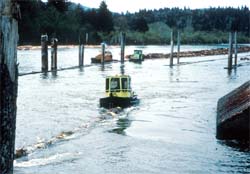
Pond Boat
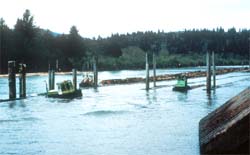
Pond boats in action
|
- The bilge area must be inspected, maintained, and ventilated to prevent accumulation of highly combustible materials.
1910.265(d)(2)(iv)(d)
- Adequate ventilation must be provided for the cabin area on enclosed
cabin-type boats to prevent accumulation of harmful gases or vapors.
1910.265(d)(2)(iv)(e)
- Powered pond boats or rafts must be provided with at least one
approved fire extinguisher, and one life ring with line attached.
1910.265(d)(2)(iv)(b)
|
|
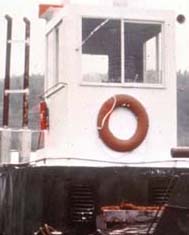
Life ring on pond boat
|
|

|
|
|
|
Hazards/Solutions:
Workers receive injuries from the log chute or slip
and fall if footing is inadequate along walkways or log hauls.
- Walkways along log hauls must have a standard handrail on the outer
edge and cleats or other means to assure adequate footing and enable
employees to walk clear of the log chute. 1910.265(d)(2)(vi)(a)
Workers receive injuries due to equipment failure
or by using equipment in an unsafe manner.
- Log haul bull chains or cable must be designed, installed, and
maintained to provide adequate safety for the work need. 1910.265(d)(2)(vi)(b)
- Log haul gear and bull chain drive mechanism must be guarded.
1910.265(d)(2)(vi)(c)
- Substantial troughs for the return strand of log haul chains must be
provided over passageways.
1910.265(d)(2)(vi)(d)
- Log haul controls must be located where the operator will be in the clear of logs,
machinery, lines, and rigging. In operations where control is by lever
exposed to incoming logs, the lever must be arranged to operate the log
haul only when moved toward the log slip or toward the log pond.
1910.265(d)(2)(vi)(e)
- Install a positive stop on all log hauls to prevent logs
from traveling too far ahead in the mill.
1910.265(d)(2)(vi)(f)
Employees may be struck
by moving logs on the log deck.
- Provide overhead protection for employees working below
logs being moved to the log deck.
1910.265(d)(2)(vi)(g)
- Provide log wells with safeguards to minimize the
possibility of logs rolling back into well from the log deck. 1910.265(d)(2)(vi)(h)
|

|
|
|
| Home
| Log Handling
| Log Breakdown
| Dry
Kilns
| Lumber Storage
|
| Plant-Wide Hazards
| Definitions
| Additional
References
| User
Guide
| Credits
|
|
|
|
